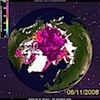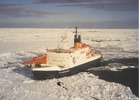 Another day, another bet on sea ice. A few days ago, a regular reader of HT emailed to ask me if I could provide some support in a long series of comments to a post at Poneke! about the showing of Swindle. So I did (my contributions start here). And now I have another bet on this northern hemisphere summer’s sea ice minimum, with a commenter calling himself “malcolm” taking the Stoat position (cold side = more ice than last year, not something out of the Kama Sutra). So here’s an update on events up North. Consider it a form guide, if you will.
Another day, another bet on sea ice. A few days ago, a regular reader of HT emailed to ask me if I could provide some support in a long series of comments to a post at Poneke! about the showing of Swindle. So I did (my contributions start here). And now I have another bet on this northern hemisphere summer’s sea ice minimum, with a commenter calling himself “malcolm” taking the Stoat position (cold side = more ice than last year, not something out of the Kama Sutra). So here’s an update on events up North. Consider it a form guide, if you will.
Tag: betting
Skating away (on the thin ice of a new day)
 A new forecast for this summer’s Arctic sea ice melt suggests that there’s a 60% chance that this year’s minimum will set a new record. Work by researchers at the University of Colorado’s Center for Astrodynamics Research shows that the current ice is much thinner than usual:
A new forecast for this summer’s Arctic sea ice melt suggests that there’s a 60% chance that this year’s minimum will set a new record. Work by researchers at the University of Colorado’s Center for Astrodynamics Research shows that the current ice is much thinner than usual:
“The current Arctic ice cover is thinner and younger than at any previous time in our recorded history, and this sets the stage for rapid melt and a new record low,” said Research Associate Sheldon Drobot, who leads CCAR’s Arctic Regional Ice Forecasting System group in CU-Boulder’s aerospace engineering sciences department. Overall, 63 percent of the Arctic ice cover is younger than average, and only 2 percent is older than average, according to Drobot.
The image above shows the age of the current ice cover compared to average for this time of year (you can click on the image to see a larger version). Yellow is the same as average, red is younger. For the bigger picture, visit the Arctic Ice Forecasting System pages at UC.
This has prompted me to increase my sea ice bet with William “Stoat” Connolley by £10 to £30 (plus a signed copy of Hot Topic). With the seasonal melt speeding up, the race is on…
[Hat-tip to Eli Rabett]
Here come the warm jets
 Hot Topic has devoted a lot of posts to events in the Arctic over the last northern hemisphere summer. The loss of sea ice was dramatic – there was 25% less ice in September than the previous record, set in 2005. The little graph to the left shows just far off the trend line last year’s September area really was. And as I posted yesterday, recent studies suggest that the Arctic is primed for more significant losses in the near future. If the reduction in summer sea ice continues, there are some pretty major implications for the climate of the northern hemisphere and for our modelling of the global climate, and it’s those things that I want to consider in this post. Please note: I am not a climate scientist, and there are a lot of ifs and handwaves in this argument, but bear with me…
Hot Topic has devoted a lot of posts to events in the Arctic over the last northern hemisphere summer. The loss of sea ice was dramatic – there was 25% less ice in September than the previous record, set in 2005. The little graph to the left shows just far off the trend line last year’s September area really was. And as I posted yesterday, recent studies suggest that the Arctic is primed for more significant losses in the near future. If the reduction in summer sea ice continues, there are some pretty major implications for the climate of the northern hemisphere and for our modelling of the global climate, and it’s those things that I want to consider in this post. Please note: I am not a climate scientist, and there are a lot of ifs and handwaves in this argument, but bear with me…
More ice/less ice
 More on the Arctic melt: the National Snow and Ice Data Centre updates its commentary on this year’s record ice minimum. As of yesterday, the five day moving average of ice was still moving downwards, but slowly. Their comment on the North West Passage is interesting.
More on the Arctic melt: the National Snow and Ice Data Centre updates its commentary on this year’s record ice minimum. As of yesterday, the five day moving average of ice was still moving downwards, but slowly. Their comment on the North West Passage is interesting.
The main, deep channel of the Northwest Passage (Lancaster Sound to M’Clure Strait) has been open, or nearly ice-free, for about five weeks (since August 11, approximately). Of note is the northernmost ice edge ever recorded, at 85.5 degrees North, near the 160 degrees east longitude line.
Meanwhile, the RV Polarstern (see pic), near to completing a voyage through the Arctic as a contribution to International Polar Year, reports that large areas of this year’s ice have only been 1m thick – a 50% reduction on only 6 years ago. When the ship got close to the pole, it started raining. Ursula Schauer wrote (in early September):
A whole day of rain within 150 km of the North Pole came somewhat as a surprise! For the past few weeks, one low-pressure system after another has continuously carried warm air from northern Siberia (15°C at the Lena estuary!) towards the central Arctic Ocean. In this way the sea ice disintegrates more and more right before our eyes.
Meanwhile, I’ve bet Stoat (aka William Connolley) that 2008 will beat 2007’s record low. But only £10…
